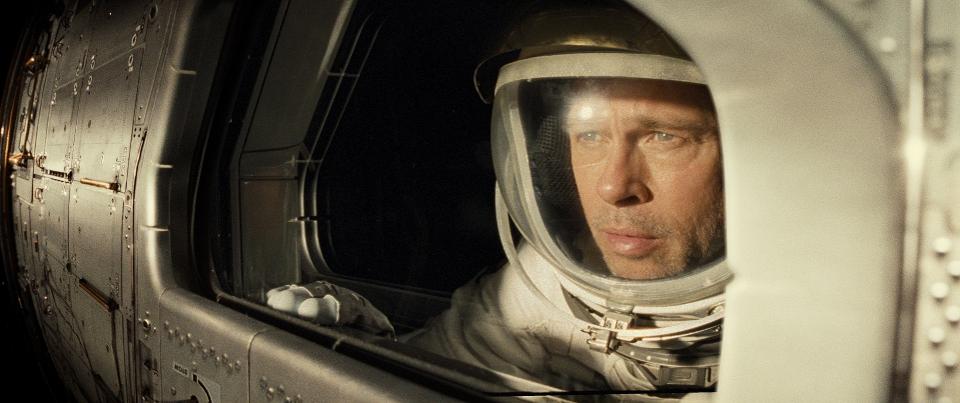Sorry, nothing in cart.
‘Ad Astra’ Strives To Immerse Audience In Epic Interstellar Experience
- By michael@cvcteam.com
- |
Ad Astra means simply “the stars” in Latin. The title of this epic space adventure, starring Brad Pitt, is derived from the Latin phrase “Per aspera ad astra”, or “Through hardship to the stars.” The movie is part thriller and part action movie, but the core message is to explore the psychological and sociological consequences of space travel.
I have not seen the movie myself yet, so you are safe from any major spoilers. I can only relay what I know from the trailer and production notes, and my brief conversations with people involved in the production of the movie. My initial perception is that it seems like a movie with deep philosophical impact—a movie that isn’t just a space adventure, but makes you ponder the human experience and some of the potential existential challenges we may face as we venture beyond planet Earth. I expect it to be on par with Contact and Interstellar in that regard.
Deeper Meaning
At face value, the movie revolves around Brad Pitt’s character, Major Roy McBride. Roy is an astronaut who has followed in the footsteps of a father he lost at age 16. H. Clifford McBride (played by Tommy Lee Jones) disappeared on a mission—the Lima Project—to the edge of interstellar space to get a clearer view of the universe from outside the magnetic field of the Sun. The US government believes Clifford McBride might still be alive out there, and pulls Roy McBride into a mission to track him down.
There is a fair amount of intense action in the movie, but ultimately it is more an exploration of mankind and the question of whether we can—or should—exist in space. James Gray, the writer, director and producer of Ad Astra, explained, “There have been so many great films made in the science fiction genre, but how many of them are there that move you? I wanted to do something that was the opposite of most space travel movies that offer a somewhat positive view which results in meeting aliens, intelligent life that are benevolent or at least interesting enough to involve us. I tried to do the opposite of that and say, what if there’s nothing? What if there’s a kind of emptiness out there that we can’t even grapple with?”
“I was anxious to explore the fact that as human beings, we’re not really meant to be in space,” continued Gray. “We’re not designed to be floating around 250 miles outside the atmosphere. We’re not built for that, and we’re never going to be built for that. And that is going to have a cost.”
Trying to Ensure It Feels Real
One of the things that I find most intriguing and impressive about movies—particularly science fiction movies (at least the ones that are done well)—is how well they stick to concepts and technologies that are at least theoretically plausible. Consider the number of things that were introduced through the original Star Trek TV series that were complete fantasy 50 years ago but are now commonly used devices.
I had an opportunity to speak with Garrett Reisman, one of the science advisors for Ad Astra. Reisman knows a fair amount about how to make space travel look real—he’s been there, done that. Reisman is a former NASA astronaut who flew two Space Shuttle missions to the International Space Station (ISS) and conducted three space walks. Reisman went on to work with SpaceX and is now a professor at USC.
Reisman told me that he strived to instill a sense of realism and help ensure Ad Astra portrayed space flight as accurately as possible. At the same time, though, he stressed that the story takes precedence. He told me that, ultimately, the movie is not intended to be a documentary and there has to be some allowance for artistic license that adds drama and makes the experience better for the audience.
He shared some thoughts on the deeper concept of the movie in the production notes for Ad Astra. “A lot of us now are looking at maybe making a sustainable human presence on another planet in our solar system, and specifically the red planet, and thinking about all the wonderful utopia that it might be,” he states. “And I think that we have to consider, what if it turns out that it’s not a utopia. What if it’s a dystopia?”
Reisman told me that he feels like Ad Astra gets it right. He told me that the movie relies on space travel vehicles and technology that are beyond where we are today—as you would expect in a science fiction movie—but still within the realm of what is potentially feasible. He was particularly proud of how the feeling of traveling in a vehicle in microgravity or doing a space walk are portrayed in the movie. Having done both himself, he said they feel “real” to him.
I’m looking forward to seeing Ad Astra myself. I love a good science fiction movie. I love it even more when it ponders philosophical and existential issues and makes you think long after the experience of viewing the movie is over.
Follow me on Twitter or LinkedIn. Check out my website.


Leave a Reply